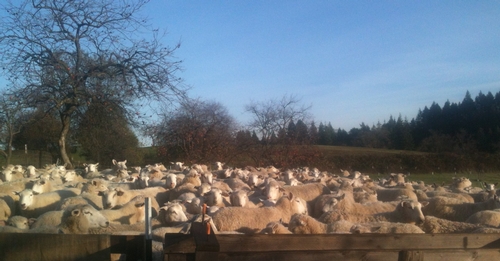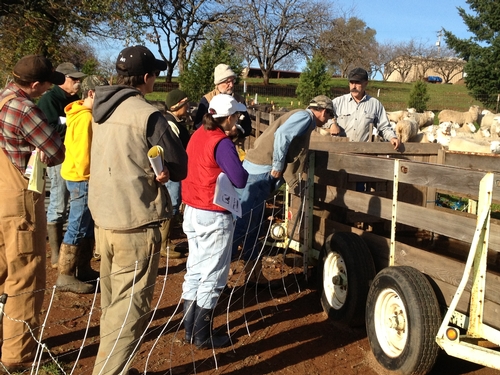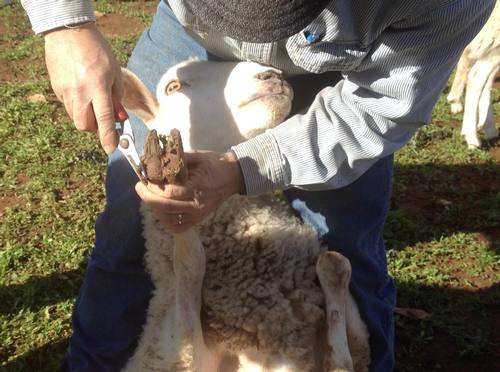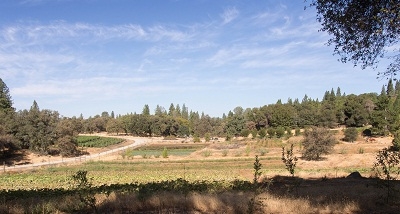Foothill Farming Blog
Building a Tool: discoveries along the way
First of all, it’s not your typical farm tool. It isn’t a hoe, or a shovel, or even a tractor implement. But, it may help you harvest faster, increase your production, and lead to greater profits. By now, with the dawn of agriculture some 12,000 years or so behind us, it is reasonable to believe that every tool we really need has already been invented. Of course, there can never be enough variations of the hoe in the minds of the tool manufacturers. However, during the past several months, I have noticed a gap in the pantheon of farm tools.
The type of tool I’m talking about is a financial tool. Try though I may, I just cannot find a tool for small-scale farmers that help them address costs of production, profit margins, gross margin ratios, and other metrics in an accessible, comprehensive, and (this last part is very important) farmer-friendly manner. If I am remiss in my search, please let me know ASAP. However, I suspect that I am not. I have come across many books that either over-simplify this process, or address important accounting/book-keeping concepts while leaving out a comprehensive analysis of the operation in a (again, very important) farmer-friendly format.
In plain terms, here’s what I find lacking. Every small-scale farming operation here in Placer and Nevada Counties produces more than one crop. For an operation that produces one crop, it is very easy to get at the costs of production, profit margin, gross margin ratio, etc for that particular crop. However, when the farm starts to add crops to that list, the challenge of isolating these metrics becomes increasingly complicated. Any literature about this tries to address the problem by presuming that these crops exist by themselves, as if they were a one-crop operation. They do not.
In short, I seek to create a tool that can generate various metrics for a given crop, in the broader context of the operation as a whole. Translation: I am building a tool that will allow a farmer to know metrics for their carrots, beets, lettuce, broccoli, and whatever else they grow. I feel it’s a necessary step for farmers to be able to run a profitable business, and thus continue to farm.
Why is this important? Well, farmers may be selling their crop under their costs of production. For instance, through this process, I learned that for several years I was wholesaling bunched carrots for less than it took me to get them to market. Ouch. Maybe that’s why I was not hitting my salary goals! How many farmers are like me? Perhaps none. Perhaps several. Yet, I would guess the answer is that most farmers have this issue.
If you are a farmer, I recommend that you not be afraid of your numbers. Every little bit will help you and your business to succeed, and knowing your numbers may give you a measure of control in an otherwise unpredictable industry.
10,000 Hours of Farming
In his book Outliers: The Story of Success, Malcom Gladwell writes that, “To become a chess grandmaster also seems to take about ten years. (Only the legendary Bobby Fisher got to that elite level in less than that amount of time: it took him nine years.) And what’s ten years? Well, it’s roughly how long it takes to put in ten thousand hours of hard practice. Ten thousand hours is the magic number of greatness.” While Gladwell is discussing outliers – those individuals in specific professions that stand head-and-shoulders above their peers, I think the “10,000 Hour” rule applies to many activities, including – in my case – sheep farming.
I don’t claim to be an expert shepherd – I’m often humbled by the realization of how much I don’t know about raising sheep. However, I estimate that since I started raising sheep on a commercial scale in 2006, I’ve spent in the neighborhood of 14,000 hours doing everything from moving portable electric fence to trimming hooves to analyzing the economics of my business. And while I still have more questions than answers about how to make my living by raising sheep, there are parts of this business that are far easier now that I’ve invested so much time!
Some of the benefit is akin to muscle memory. If you repeat a physical motion enough times – like playing the piano – eventually your muscles remember where to place your limbs and digits. These movements become second nature. Last week, we completed our annual task of trimming feet, a process that involves tipping every ewe onto her backside and trimming all four of her hooves. With 250 +/- sheep, this meant trimming approximately 1,000 feet! Just 5 years ago, such a task would have left my back sore for several days – and it would have taken three people just to treat our flock of 100 ewes in a single day. Last week, with help from a few friends, we treated 250 animals in about 8 hours.
Building electro-net fencing is another example of increasing efficiency. I estimate that I put up and take down my 164-foot rolls of electro-net between 700 and 800 times in a year. When I started learning how to use the fencing 7 years ago, a 6-net paddock (which encloses about 1.25 acres) took me several hours. Two weeks ago, I built a 16-net paddock (enclosing 9.25 acres) in less than three hours. Once again, I’ve now built enough fence that I learned how to be as efficient as possible.
Some of the benefit of putting in the hours comes from learning from experience and knowing what to expect in certain situations. When we first started using livestock guardian dogs to protect our sheep from predators, I was always extremely worried when a dog got out of my pastures. Typically, I’d drop everything else I was doing and try to catch the dog. To my dogs, this became a great game – I could almost see them thinking, “let’s see how long he’ll follow me!” The dogs would eventually decide to come back on their own, but it took me several years to realize this fact. Last month, one of the dogs got out while I was sorting our rams from our ewes in a pasture. Rather than put the already-separated rams back with the ewes and track down the dog, I continued with my task. By the time I’d sorted the last ram from the flock, the dog had returned from his jaunt and was ready to be back with his sheep. I realize that this story doesn’t sound like much – after all, it only saved me 30 minutes of not chasing the dog all over the ranch. However, I find that each time I can apply my accumulated experience and knowledge I save myself (and my animals) time and stress – and these savings add up like compounding interest!
Finally, spending time working on the business is as important as spending time working in the business. When I’m working “in” the business, I’m doing many of the things I’ve discussed above. When I’m working “on” the business, I’m thinking about bigger questions – how should I market my lambs next year, for example. I’ll admit I’d much rather spend the day working with my sheep than in front of my computer, but I find that the quality of my “on-the-business” work improves the more I do it as well. For instance, we’ve decided this year to keep our sheep year-round on properties much closer to home, which will reduce our overhead costs substantially. We’ve adjusted the scale of our operation to fit the land we can access without putting the sheep on a trailer.
I suppose that this idea is at least indirectly related to scale. The more sheep you raise – or the more carrots you grow – the more quickly you cross the 10,000-hour threshold. Regardless of size, however, the investment of time in farming eventually pays dividends in skill level (and hopefully in profitability).
The purpose of these stories is not to brag about my prowess as a shepherd but rather to illustrate that there is no substitute for putting in the time as farmers. While I believe strongly in the power of planning and analysis, at some point we all have to implement our plans – we have to farm! If we’re observant – and humble enough to learn from our mistakes – this investment of time will pay off. While 10,000 hours of working with sheep won’t make me as famous (or as wealthy) as Buster Posey (the Giants MVP catcher for you non-baseball fans) it will make me a better farmer!
Tools For a Small Farm
Tools. I love tools, and when you are farming you need really good tools and lots of them. When most people think about the tools used on a farm, they think tractor. Tractors! I love tractors, but when you are farming on a small scale, you really don‘t use tractors all that often. In fact, buying a four wheel tractor when you are farming on a small scale can be a fatal financial mistake. Big farms use tractors all the time because they have to. Tractor mounted equipment is the only way to keep hundreds of acres tilled, weeded and harvested. Buying a tractor (new or used) requires a large outlay of precious farm capital and the return on your investment is low if you farm a small amount of land. Tractors earn their keep by working ground, not by sitting in the machine shed. Profit margins are usually small on farms, and if you spend all of your cash flow paying off an equipment loan, you are not going to have enough income to meet other expenses and you will be unable to pay yourself a living wage. No one should work for free, including the small farmer!
I farm about three acres give or take an acre or two, depending on the season. Summer takes more acres than winter due to all the sprawling crops like melons and squash that eat up space and force the farm to get bigger in acreage. Winter crops are more space efficient: the very nature of the plants allows them to be grown closely together. To farm three acres, hand tools rule the day.
Here is a list of what I consider to be the essential hand tools to work the soil and control the weeds for small scale agriculture (e.g. one to five acres):
- A good walk behind tractor with a tiller. The best ones are made in Italy. I drive a Ferrari when I am out in the fields. Notice that I said “walk behind tractor.” Yes, you can change attachments on these machines and use them for as many tasks as you own attachments (anything from mowing to baling hay).
- Wheel hoe: I love this tool! What is it? Well, that is hard to explain, but basically it is a swivel hoe attached to a frame with a single wheel in front and plow type handles for the operator. These tools work really fast, taking out small weeds in the walkways between crop beds and for the areas between rows of plants. They have interchangeable attachments and allow one person to cover a lot of ground quickly.
- Swivel hoes (also known as “hula hoes”): these tools have a square shaped head that has a narrow cutting blade that swivels back and forth. There are lots of different sizes and I think you should have at least three sizes: a three-inch wide, five-inch wide, and a seven-inch wide head. I use these to kill weeds between plants in both directions: across the bed, and down the length of the bed.
- An assortment of small hand tools, ranging from masonry trowels with the point cut off for transplanting, to Nantucket welders that allow close in weeding of young plants, to Japanese hoes with razor sharp carbon steel blades for really fine weeding when you don’t want to move the soil around too much.
These are the basics, but like anything else, the basics are the essentials upon which everything else is built. I use these tools more than any of the other items in the toolshed.
On My Farm
On my farm, there’s a hammock. My hammock hangs outside the back of the house, near our bedroom. It’s a perfectly peaceful place on the farm, removed from the cropland and hustle of the working fields. The hammock’s inviting arc hangs between a plum tree and a persimmon tree. From a certain distance, it’s easy to imagine it as the Cheshire Cat-like grin of an invisible creature, smiling away at some self-possessed pleasure.
In the Summer you could, if you wanted to, lie in the hammock and reach up to pluck a ripe plum to eat, savoring the sweet, slightly tart juice, not caring if it drips down your chin. Or, in the Fall after first frost, you could enjoy watching a woodpecker work its beak into a bobbing persimmon.
Truth be told, I’ve never lain in the hammock. Not once. It’s a nice idea, and I’m certainly deserving of a good rest and a chance to consider the beauty of this farm I call home from the shade of the fruit trees. I deserve a chance to read a book, too, or take a nap in the middle of the afternoon when it’s really too hot to work. I could even see myself on a hot night, when the daytime heat penetrates the shadows and it cools off at night only a little, taking my pillow out to the hammock and enjoying that indescribable sensation of a subtle breeze like cool moonlight across the hair of my forearms, wicking away the heat.
But, like I said, I’ve never done it, not once. Now, don’t misunderstand me. Farming has its pleasures, and there are plenty of them. The well-tended fields of a farm, weeded, cropped in a patchwork of diverse vegetables, brimming over with the sounds of contented humans happily working away, is really a beautiful thing. It conjures up all that is good, productive and peaceful, the best we humans seem to be able to do for this world and for ourselves.
I imagine, too, that when you read the first sentence of this writing, you were fulfilled in your expectations of what life on a small farm is like. Hard work, but contentment and peacefulness filling in all the moments of the day. People singing while they work, the cow in its field and the pigs in their wallow enjoying the fond words of the farmer as he or she moves from task to task. Sitting down to the noon meal surrounded by dirty faces, calloused hands, plenty of laughter and good appetites—Amen!
In a certain way, you’re not mistaken. The pleasure of farming is real. Through heat, cold, wet, dry, crop failure, exhaustion and other pestilence, it’s still possible to regularly touch the reasons why one farms. I’ve never been shy about saying that the real pleasure in farming is all about a kind of love or, better yet, a fidelity to place that I’ve felt through all the years of working here. I feel a sense of responsibility to the place that is this farm that I’d be quick to say is not unlike that which, as a parent, I feel towards my children. And, just as the relationship to a child is an uncommon combination of burden and blessing, so too is my relationship to this place. In this sense, love is not a very descriptive word for privilege and responsibility, but it’ll have to do.
Still, while the pleasures of farming endure through all the unpredictability of a season like the counterpoint bass notes of a beautiful lyric song, the recognition of that pleasure is likely to be as fleeting as the flight of a bird.
I think of it this way: I jump off the tractor mid-field because it’s time to turn off irrigation water in another corner of the farm. On my way, I notice that a drip line is leaking, probably cut by a gopher, and there’s a large pool of water that threatens to drown a bed and will, in any event, encourage another burst of weeds. Searching my pockets, I don’t have a coupler to replace the leak, so I change direction and head to the farmstand for a coupler. Searching through the bins, I realize we are out of couplers, so I walk to the pile of discarded drip tape, where I quickly find a coupler that wasn’t removed when the drip tape was pulled up. With coupler in hand, I head back to the leaky drip line but I then get called over to the washing station to check the quality of some salad turnips we are harvesting for the co-op. The roots look fine, but the foliage is showing early signs of flea beetle damage. Deciding that it’s still marketable, the washing and bunching resumes, but there’s another question from an employee that’s cultivating onions in Field 2. We spend some time talking about what’s reasonable to accomplish efficiently in the face of too little labor and too many weeds, and then my cell phone rings. The co-op forgot to include parsley on their order, so I take down their order and walk back to the farmstand, where I write in the new order on today’s pick list. I then review with the person who is going to pick the parsley how many stems are in each bunch and how to pack them for the co-op. Since I’m near my office, I decide I’d better check email to make sure that there aren’t any important communications from customers placing special orders for bulk items. There’s an urgent email message from my ex-wife about our daughter, so I call her back to talk with her. We end up talking for about 15 minutes, at which point I remember the leaking drip tape, so I quickly get off the phone and head back over to the field where the leak is. It takes but a few seconds to fix the line, and I resume my trip to turn off the irrigation in another corner of the farm. While I’m walking over, I hear a familiar sound and, looking up, I’m treated to the sight of a huge flight of migrating sandhill cranes.
I trust it’s clear that I’m not saying there’s no pleasure in farming. There most certainly is, and in abundance when you look closely enough, but what I’ve described above is about as good as it gets in a day on the farm, repeated more or less to the day for eight months straight. The particular pleasure is always different, but it can be as short-lived in a day as the moment the light first hits the tops of the trees at sunrise. And, it’s important to say, you have to look for the pleasure, seize it greedily, and remember it always, or you’ll be buried in no time in fretting and disappointment.
When I set out to farm, I expected I would have time. Time to farm artfully, time to be creative, time to tend the fields, time to say grace. I expected I would be fulfilled, contented, and peaceful. I expected that all the crops would be beautiful and everyone would want to buy them. I expected that when I needed something, I’d be able to buy it, or make it, or have it through one means or another. I expected that I could build this farm from scratch, never compromising my aesthetic sense and always progressing from one task to another or one project to another with a kind of logic. And, I never thought I’d make mistakes with any consequences.
We all know that farming requires physical stamina and some strength, and it certainly requires endurance. But again, truth be told, it turns out that it requires more mental stamina and endurance than physical strength, and lots more mental resilience and flexibility than is ever commonly appreciated. I can’t imagine an occupation that requires a person to be more of a Jack or Jill of all trades than farming, including making all the right choices at all the right times. That’s not a formula for the idyllic vision of farming that we all hold dear.
It’s true that farming is enjoying a renaissance of sorts, with a great deal of enthusiasm being brought to bear on what might fairly be called the finer things in life. It’s impressive to see how many are called to take up farming on a small scale, and what hopes and aspirations all of us farmers bring to bear on our chosen path.
In fact, many are called, but few are chosen. It turns out that beginning farming requires a lot of financial resources, along with a lot of courage and fortitude. Young people can have lots of courage and fortitude, but financial resources are scarce. Putting it all together in such a way as to make a farm pay for itself without exhausting the farmer with work and worry is something that is not widely recognized for what it is, even as more young people flock to farm.
After farming for more than ten years on this small piece of heaven on earth, I’m still wondering if I’ll be one of the chosen. Each year is a new opportunity, and each year presents its own particular challenges. The line between success and failure is, more often than not, extremely thin, and I often find myself unsure whether a particular year was a success or a failure. By what criteria, on balance?
In the end, even as I know that this is not enough, I value integrity and the beauty of my fields over financial success. I value my relationship with my customers more than I value wider recognition of our accomplishments over the past ten years. I value the interaction I have over the Farmers’ Market table with someone who wants to know how to prepare something we have to sell than the total number of pounds sold during a season. And, what’s more, I value the moment I see some inscrutable thing that happens before me as I wander these fields, leaving me to wonder at the depth of pleasure that love can bring.
Contingency Planning Workshop December 12th
Contingency Planning - admittedly, not the most attractive subject, but certainly a necessity for your farm and business.
This workshop, titled "Planning For the Worst, Hoping For the Best: How to Manage Your Farm and Ranch Liabilities," will walk you through methods and strategies to deal with adversity and challenges BEFORE they occur.
Want to cut down on your stress load? Then consider this workshop.
Here's the link: http://ucanr.org/sites/placernevadasmallfarms/?calitem=172680&g=22527
See you There!





